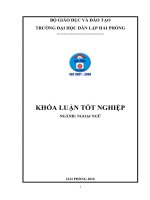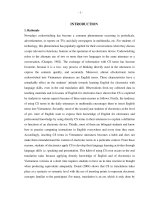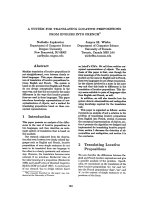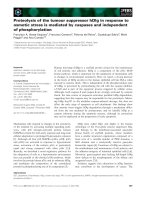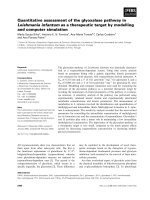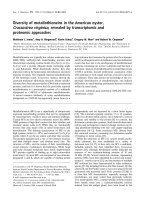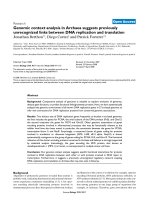Strategies in translating english songs into vietnamese applied by interpreting and translation majored students of felte, ULIS
Bạn đang xem bản rút gọn của tài liệu. Xem và tải ngay bản đầy đủ của tài liệu tại đây (499.32 KB, 86 trang )
VIETNAM NATIONAL UNIVERSITY, HANOI
UNIVERSITY OF LANGUAGES AND INTERNATIONAL STUDIES
FACULTY OF ENGLISH LANGUAGE TEACHER EDUCATION
GRADUATION PAPER
STRATEGIES IN TRANSLATING ENGLISH SONGS
INTO VIETNAMESE APPLIED BY INTERPRETING
AND TRANSLATION MAJORED STUDENTS OF
FELTE, ULIS
Supervisor: Vũ Thị Kim Liên (M.A.)
Student: Cao Thị Sao Mai
Course: QH.2017.F1.E22PDCLC
HàNội,2021
ĐẠI HỌC QUỐC GIA HÀ NỘI
TRƯỜNG ĐẠI HỌC NGOẠI NGỮ
KHOA SƯ PHẠM TIẾNG ANH
KHOÁ LUẬN TỐT NGHIỆP
CHIẾN LƯỢC DỊCH BÀI HÁT TIẾNG ANH SANG
TIẾNG VIỆT ĐƯỢC ÁP DỤNG BỞI SINH VIÊN
CHUYÊN NGÀNH BIÊN PHIÊN DỊCH, KHOA SƯ PHẠM
TIẾNG ANH, TRƯỜNG ĐẠI HỌC NGOẠI NGỮ
Giáo viên hướng dẫn: Vũ Thị Kim Liên (ThS)
Sinh viên: Cao Thị Sao Mai
Khoá: QH.2017.F1.E22PDCLC
HàNội,2021
Signature of Approval:
_____________________________________________________________
Supervisor’s Comments & Suggestions
_____________________________________________________________
_____________________________________________________________
_____________________________________________________________
_____________________________________________________________
_____________________________________________________________
ACCEPTANCE
I hereby state that I: Cao Thị Sao Mai, class QH2017.F1.E22, being a
candidate for the degree of Bachelor of Arts (Honored Program) accept the
requirements of the College relating to the retention and use of Bachelor’s
Graduation Paper deposited in the library.
In terms of these conditions, I agree that the origin of my paper deposited in
the library should be accessible for the purposes of study and research, in
accordance with the normal conditions established by the librarian for the
care, loan or reproduction of the paper.
Signature
ACKNOWLEDGEMENTS
First of all, I would like to express my sincere gratitude to my
supervisor and my teacher Ms. Vũ Thị Kim Liên (MA) for her explicit
instructions and continuous encouragement during the past 9-month period.
Without her thorough orientation and constructive suggestions, I could not
have completed the graduation thesis which is one of the most challenging
tasks I have ever experienced. Having been supervised by Ms. Liên is my
great honor and I would never regret asking her to be my supervisor.
I also would like to show my deep appreciation to 20 translation and
interpreting majored students from FELTE who voluntarily attended my thesis
conducting. Thanks to your enthusiastic support and response in my lecture,
tests and questionnaire, I could continue to go through this task.
A special thanks is given to the expert for spending his time
participating in my interview, giving me valuable advice and offering specific
recommendations for my research despite his tight schedule.
Finally, carrying out this thesis is like a completely new and terrific
adventure to me. From the bottom of my heart, I feel truly grateful to my
family, my friends, my former teachers and other close acquaintances for
standing by my side as well as taking care of me all the time. Their
tremendous support strengthens my motivation to come to the end of this
tough but great journey.
i
ABSTRACT
The global integration creates favorable conditions for culture
exchanges in over the world. In addition to cultural artifacts such as clothes,
customs, literature, music is also promoted to connect countries to countries,
people to people. For that purpose, song translation starts to be studied and
songs begin being translated from a language into many languages. In
Vietnam, though song translation has appeared for a long time, it has not been
paid significant attention. The lack of research and professional translators in
this field has led to the limitation of translated song quality, especially from
English into Vietnamese, despite increasing demand of the public. Therefore,
the study was conducted to find out strategies appropriate for translating
English songs into Vietnamese by analysing Vietnamese translated versions of
two songs which were Lemon Tree by Garden Fools and At My Worst by Pink
Sweat$. 20 translation and interpreting majored students at Faculty of English
language teacher education (FELTE), University of Languages and
International Studies (ULIS) were invited to attend a lecture in which seven
strategies suggested by Lefevere were presented. The translations of Lemon
Tree and At My Worst were done by students before and after the lecture were
collected and investigated based on the framework of Trương Vân Ánh (2020).
Besides the questionnaire handed out to the participants, an interview with an
expert was held to gather evaluation on the translations as well as strategies. In
conclusion, metrical translation was applied in translating songs most by the
students and target texts 2 (TT2) recognized to convey more musical values
than target texts 1 (TT1). However, meaning connotation was seen to still be
prioritized than non-linguistic aspects such as rhythms in translated songs.
ii
LIST OF ABBREVIATIONS
FELTE
Faculty of English Language Teacher Education
ULIS
University of Languages and International Studies
SL
Source Language
TL
Target Language
ST
Source Text
TT
Target Text
TT1
Target Text 1
TT2
Target Text 2
iii
LIST OF TABLES AND FIGURES
Name
Table 1
The number of words and syllables in the
chorus part of “Lemon Tree”
Table 2
The number of words and syllables in the
chorus part of “At My Worst”
Table 3
Singability comparison between ST and TT2
of “Lemon Tree”
Table 4
Rhyme comparison between ST and TTs of
“Lemon Tree”
Table 5
Rhyme comparison between ST and TT2 of
“Lemon Tree”
Table 6
Singability comparison between ST and TT2
of “At my worst”
Table 7
Rhyme comparison between ST and TT2 of
“At my worst”
Figure 4.1
Song translation strategies applied in
translating songs by students
Figure 4.2
Students’ assessment on the
effectiveness of translation strategies
on their work
iv
Page
TableofContents
ACKNOWLEDGEMENTS.....................................................................................................i
ABSTRACT ............................................................................................................................ii
LIST OF ABBREVIATIONS ...............................................................................................iii
LIST OF TABLES AND FIGURES.....................................................................................iv
TABLE OF CONTENTS .......................................................................................................v
CHAPTER 1: INTRODUCTION ..........................................................................................1
1.1. Rationale of the study...........................................................................................1
1.2. Research aims and research questions ..................................................................2
1.3. Significance of the study ......................................................................................3
1.4. Scope of the study ................................................................................................3
1.5. Structure of the study ...........................................................................................4
CHAPTER 2: LITERATURE REVIEW...............................................................................5
2.1. Song.....................................................................................................................5
2.2. Translation ...........................................................................................................5
2.2.1. Song translation ..................................................................................................... 7
2.3. Strategies in song translation ................................................................................8
2.3.1. Translation strategies ............................................................................................8
2.3.2. Song translation strategies ....................................................................................9
2.4. Translation quality assessment ........................................................................... 12
CHAPTER 3: METHODOLOGY .......................................................................................15
3.1. Selection of subjects ...........................................................................................15
3.1.1. Setting .................................................................................................................. 15
3.1.2. Participants .......................................................................................................... 15
3.2. Data collection ...................................................................................................16
3.2.1. Testing ................................................................................................................. 16
3.2.2. Questionnaire....................................................................................................... 17
3.2.3. Semi- structured Interview ................................................................................. 18
3.2.4. Data collection procedures ................................................................................. 19
3.3. Data analysis procedure...................................................................................... 21
3.4. The analysis of the source text in accordance with Truong’s framework .............22
v
CHAPTER 4: FINDINGS AND DISCUSSION.................................................................25
4.1. Comparison of Source Text and Target Texts .....................................................25
4.1.1. Song 1 .................................................................................................................. 25
4.1.2. Song 2 .................................................................................................................. 29
4.2. Result of the questionnaire ................................................................................. 34
4.3. Result of the interview ....................................................................................... 36
4.4. Discussion of the findings ..................................................................................37
4.4.1. Opinions of students on the effects that applied strategies have on
translated versions ......................................................................................................... 37
4.4.2. Opinions of the experts on the strategies ........................................................... 38
CHAPTER 5: CONCLUSION .............................................................................................39
5.1. Summary of the findings ....................................................................................39
5.2. Limitation of the study ....................................................................................... 40
5.3. Suggestion for further research ........................................................................... 40
REFERENCES ......................................................................................................................41
APPENDICES .......................................................................................................................44
Appendix 1: Online Test ........................................................................................... 44
Appendix 2: Lecture Plan.......................................................................................... 45
Appendix 3: Questionnaire ........................................................................................ 53
Appendix 4: Participants’ translations .......................................................................55
Appendix 5: Interview ..............................................................................................72
vi
CHAPTER 1: INTRODUCTION
This chapter offers a succinct overview of the whole research by introducing
the researcher’s intentions to do the study, the research aim and significance as
well as the scope and structure of the study. Additionally, two research questions
are revealed in order to present a clearer orientation of the research.
1.1. Rationale of the study
Since the earliest civilizations came into existence, human beings have
constantly desired to exchange and spread culture. History has witnessed a number
of culture transmission methods employed by groups of people in society and
translation is always an outstanding way to transmit culture. In our common
knowledge, culture is perceived as every value and practice that people have
created or done in a social environment. Due to its importance in shaping our social
relationships, forming our daily experience, maintaining social orders, and defining
the world, culture has actively been elaborated within sociology. Harris (1980)
viewed culture as “learned and shared behavior”, something in which feelings are
expressed through many facets encompassing language, religion and art. While
language plays a pivotal role in every aspect of life and religion serves as a prop of
human beliefs, art exists as a testament for cultural progress and achievements.
Among the art types, the popularity of music can obviously be seen worldwide.
In the course of history, music is considered one of the most treasured
creations of humankind. When the first composers realized that music could
combine with speeches to describe the outside world, songs were created with
emotional melodies and meaningful lyrics. Through songs, people express
themselves, discover unexpectedly imaginative ideas in their minds and make
friends with people of different backgrounds. Along with the global integration,
music has been spreading over the geographic boundaries, from a country to other
countries, from a region to other regions. And to deliver hidden connotations in
each piece of music, songs have been translated.
However, unlike musicians who write songs by adding melodies and
rhythms into verbal sentences, translators have to make every effort to maintain the
1
musicians’ original intention and create a singable song as well. Despite the
significance of music in our daily lives, song translation did not draw much
attention until recently. Although there has been a variety of research concerning
approaches to translate songs (Low, 2005), choices in song translation (Franzon,
2008), most of the research focused on song translation within Europe and not
many studies were conducted on strategies that are appropriate for translating songs
of different languages.
In Vietnam, due to the invasion of overseas cultures, an increasing number
of people are listening to foreign language songs, especially English ones. This
tendency has led to the creation of many Vietnamese translated versions of English
songs. Though several research has been done, song translation has not been paid
great attention to by professional translators in general and interpreting and
translation majored students in particular. An enormous demand for Vietnamese
translation versions of English songs has emerged, leading to the increasing
concern about this field. However, songs are still mostly translated by nonprofessional translators like students.
The study is carried out to investigate strategies applied to translate English
songs into Vietnamese by students at University of Languages and International
Studies, Vietnam National University (ULIS, VNU), specifically translation and
interpreting majored students in Faculty of English Language Teacher Education
(FELTE). The purpose of this study is to give the students an overview of song
translation, thereby, encouraging them to elaborate in this field as well as applying
proper strategies to translate songs successfully. Besides, it is anticipated to find
out a basic set of strategies used to translate English songs into Vietnamese,
contributing to the shortcomings of previous works on this topic.
1.2. Research aims and research questions
The research aims at finding out what strategies are adopted in translating
English songs into Vietnamese by FELTE students and the effects of those
strategies on the translations by comparing the original songs and the translations
according to six rules suggested by Trương (2020) which are singability, word and
2
syllable quantity, rhymes and rhythms, keywords, themes and grammar accuracy.
Besides, it is hoped to form a basic foundation of proper strategies in translating
English songs into Vietnamese.
This study is intended to address these two following questions:
Question 1: What strategies are adopted in translating English songs into
Vietnamese by translation and interpreting majored students of FELTE?
Question 2: To what extent do the applied strategies affect the quality of the
translation?
1.3. Significance of the study
Until quite recently, musical materials have traditionally been considered
outside the borders of translation studies (Franzon, 2008). He added that the lack of
professional identity as to the people translating songs might be a reason behind
this neglect. In fact, songs are currently being translated mostly by music
enthusiasts. Since only a small number of translators are practicing in this area,
song translation cannot stimulate great interest among scholars. Additionally,
concerning the belittlement of song translation, Susam Sarajeva (2008) supposed
that the complexities and challenges viewed from a methodological and a multidisciplinary viewpoint may also be some of the barriers for research on the
translation of songs. Therefore, this study is conducted with the hope to provide the
students of FELTE who want to be future translators with insights into the practice
of translating songs in general and English - Vietnamese song translation in
particular.
Since songs are one of the most important cultural symbols of humankind
and translating songs is reproducing a part of culture, another aim of the study is to
benefit students in studying English and other majoring subjects. Besides, it is also
anticipated that the research will identify the strategies employed by FELTE
students when dealing with musical unique characteristics, semasiology and
aesthetics as well, thereby contributing to the development of theoretical
foundation of English -Vietnamese song translation and becoming a useful source
of reference for further studies.
3
1.4. Scope of the study
20 third and fourth-year students majoring in English translation and
interpreting in FELTE are chosen to participate in the study. Those students not
only have a good command of both English (source language) and Vietnamese
(target language) but also are similar with translation theory and basic translation
skills. These students are assigned to translate two selected songs and do a
questionnaire.
Lemon Tree performed by Fool’s Garden and At My Worst by Pink Sweat$.
These two are included in the top - listened on online platforms, especially Tiktok,
in Vietnam. However, there have been no successful translations that are singable
yet.
1.5. Structure of the study
The research is divided into five chapters and the content was arranged as
follows:
Chapter 1 – INTRODUCTION – gives an overview of the study. In this
chapter, the rationale to choose the thesis topic, the aims and research questions are
revealed. Besides, the scope and the significance and the structure of the study are
also provided.
Chapter 2 – LITERATURE REVIEW – goes through the results of the
previous studies within related field and revises background knowledge in order to
form the theoretical frameworks of the research.
Chapter 3 – METHODOLOGY – indicates the orientations of the study.
This chapter describes the methods and instruments used in doing the research
containing data collection and analyzing techniques.
Chapter 4 – FINDINGS AND DISCUSSIONS – presents translated versions
done by translation and interpreting majored students of FELTE. Following that,
translated songs are assessed based on Truong’s framework with six aspects and
then the strategies applied in the process of translating songs are pointed out as well.
4
Chapter 5 – CONCLUSION – summarizes what has been found out in the
study. Comments are given and limitations of the research are mentioned so that
further studies of the similar topics can take it as potential reference to investigate.
At the end of the study, the list of references is presented.
5
CHAPTER 2: LITERATURE REVIEW
This chapter establishes a bond for the study by looking over previous
studies pertaining definitions of song, translation, song translation, strategies in
song translation and translation quality assessment.
2.1. Song
Franzon (2008), in an article written about the choices in song translation,
described ‘song’ as “a piece of music and lyrics – in which one has been adapted to
the other, or both to one another – designed for a singing performance”. Among
three aforementioned features, Franzon suggested that the third one was the most
crucial. Similarly, Gorlée (2002) proposed that “a song in a printed score would
still indicate a singing performance as its full or final realization”. In summary, the
term ‘song’ refers to the combination of music and verbal language created to serve
singing performance.
2.2. Translation
The twenty-first century has witnessed the unprecedented development of
translation. Millions of people are moving around the world to find out new
opportunities and better lives. Translation has become a separate study concerned
by a number of theorists. Because of its complexity, a variety of explanations for
this concept have been given.
Oxford learner’s dictionary defines ‘translation’ as either “the process of
changing something that is written or spoken into another language” or “the process
of changing something into different form”. In the eyes of laymen, ‘translation’ is
merely a linguistic process in which a translator needs to be fluent in both
languages to transfer a source text into a competent target text. The fact that the
role of the translators has been depreciated is shown with this assumption.
Although realizing the importance of the translator in the translation process,
Catfold (1965, p.1) put emphasis on linguistic aspects of translation and evolves his
translation theory by examining linguistic characteristics including extent, meaning,
level of languages, phonological and graphological translation. The distinguished
Scottish linguist and phonecian wrote down in his research that translation was the
6
process of rendering a text from one language into another language but the
semantic relations between two languages were paid little attention to. Similarly,
Newmark (1988) also mentioned the term ‘translation’ as the practice of depicting a
source language text into a target language without changing the author’s original
intention. He defined semantic translation as the practice focusing on source
language (SL) and to be used to transfer expressive texts while communicative
translation was inclined to target language (TL) and convey informative texts.
Newmark held the belief that there was no extremism in translation due to the
difference between linguistic aspects. The developments in Newmark’s theory can
be obviously seen, however, his understanding of translation is still confined to
linguistic level.
In a broader perspective, Nida (1964, p.12) stated that translation conveyed
the closest lexical and stylistic equivalence of the source language text. In his view,
translation was regarded as an art and the perfect translation was the one viewed as
the original version, not a translated version. Different from Newmark (1988), Nida
(1964, p.4) believed “each language has its own genius, and anything that can be
said in one language can be said in another”. By focusing on “the closest natural
equivalence” of the source language message, one could find out the way to get an
ideal translation. Also widening the concept of translation, Bassnett (1988), cited
by Jixing (2013) in the article named Translation Definitions in Different
Paradigms, “translation is not only a kind of pure lingual activity but also a kind of
communication intra-culture and inter-culture.” Although sharing the same thought
with Newmark that no languages had structures, syntax, and vocabulary in common
and there was no translation identical to the original, she opined that translators
could make adjustments to fill in the blanks created by the lack of equivalents in
the target text. Translation, in Bassnett’s view, is not just a straightforward process
but it has become a form of rewriting. The status of translators regains its worthy
appreciation.
7
2.2.1. Song translation
For a long time, the translation of songs has been a controversial issue that
provokes a lot of discussions among scholars within the field. The term ‘song
translation’ was regarded as a type of constrained translation introduced by Titfold
(1982) in a research on the restriction of verbal text as a consequence of space,
synchronicity and visual scenes in subtitling. Agreeing on this definition, Mayoral,
Kelly and Gallardo (1988) in their research suggested that all types of translation
that not only involve written texts but also the influence of media – related aspects
such as images or music could be counted in constrained translation and all kinds of
constrained translation require a semiological approach taking the presence off nonlinguistic codes into consideration, not linguistic factors alone.
In a completely different opinion, other scholars considered song translation
as poetry translation. As noted by Franzon (2008), the way in which song lyrics
were shaped the same as the way a poem is organized. Both songs and poems have
a certain level of complexity due to their textual structure. According to Jakobson
(1960), rhyme, metre, rhythm and parallelism could be included in a collection of
common principle variations in poetry and the experience of verbal flow produced
by the interplay of sounds is equal to that of musical tempo. Jakobson supposed
that it was impossible to translate poetry except for using transposition due to its
own linguistic form and aesthetics it had to hold. Lê (2010) regarded song and
poem translation as a special kind of translation called normal translation combined
with partial phonological translation. Normal translation was to deliver three
aspects including vocabulary- grammar, semantics (content) and pragmatics (the
impact of the text on the reader) from ST into TL. However, for several types of
texts such as poems and songs which contained special factors, the translator had
to put one out of three in priority. Contrary to those viewpoints, Low (2005)
indicated the difference between song translation and poem translation and
suggested that song translation should focus on five features: singability, sense,
naturalness, rhythm and rhyme.
8
Though there were various connotations for the concept of ‘song translation’,
to be a translated version of a song, a second version of a source song had to
maintain important musical values and/ or lyrics and/ or sung performance to be
replicated in a TL. (Frazon, 2008).
2.3. Strategies in song translation
2.3.1. Translation strategies
The term ‘strategy’ was hardly investigated in translation studies and needs
more precise definitions (Lörscher, 1991). Lörscher conceptualized a translation
strategy as “a potentially conscious procedure for the solution of a problem which
an individual is faced with when translating a text segment from one language into
another language” and divided strategies of translation into ‘global’ and ‘local’
strategies. As cited by Plonska (2014), the aim of global strategies was to respond
the question “how to translate this text or this kind of text”, while local strategies
put emphasis on the question “how to translate this structure/ this idea/ this item”.
Newmark (1988) contributed to the theory of translation and gave the classic
concept of translation methods and translation procedures. Although the names are
different, translation methods and procedures are obviously indicated to be equal to
global and local strategies respectively. Newmark also mentioned the distinction
between translation methods and translation procedures in his study stating that
“while translation methods relate to the whole texts, translation procedures are used
for sentences and smaller units of language”. He classified translation procedures as
follows.
- Transference: is a process of transferring a SL word to a TL text.
- Naturalisation: adapts the SL word first to the normal pronunciation, then
to the normal morphology (word-forms) of the TL.
- Through translation: is the literal translation of the SL text.
- Shift or Transposition: involves a change in the grammar from SL to TL
- Modulation: involves a change of viewpoint, perspective and thought.
- Cultural equivalent: A SL cultural word is translated by a TL cultural word.
9
- Functional equivalent: is the use of a cultural free word to neutralize or
generalize the SL word.
- Descriptive equivalent: is that the meaning of the SL word is explained in
several words.
- Couplets: combine two, three or four of the above-mentioned procedures
respectively for dealing with a single problem.
- Reduction and expansion: is rather imprecise translation procedures,
sometimes practised intuitively by the translator.
- Paraphrase: is an amplification or explanation of the meaning of a segment
of the text.
- Notes, additions, glosses: adds more information. Additional information
can be cultural, technical, linguistic.
However, according to Königs (1987) and Wills (1983), cited by Lörscher
(1991), translation methods and translation strategies contained different
connotations. In their perspective, translation strategies were “procedures, often of
a highly individual kind, which are applied when a source-language text is
transferred into the target-language” and which “can, but need not, result in an
optimal translation”. Whereas, translation methods “are supra individual, tried and
tested procedures which, when applied systematically by the translator, guarantee a
high degree of success”.
Considering previous theories, Kearn (2009) in Routledge Encyclopedia or
Translation studies, edited by Mona Baker and Gabriela Saldanha, supposed that
strategies and procedures were substitutable in the field of translation.
2.3.2. Song translation strategies
When it comes to song translation, Low (2013) suggested three strategies
used to translate songs which are translation, adaptation and replacement. Low
pointed out that translation was a very close rendition of the original lyrics in the
TL without changing the tune. Rather similarly, adaptation referred to a more
semantic rendition of the original lyrics in the target language by keeping the tune
same. Unlike the two aforementioned strategies, replacement referred to the
10
rewriting of the original text with many changes in theme, setting and structure but
the tune was maintained. Based on Low’s framework, Franzon (2008) widened his
theory of song translation and introduced a group of five strategies including: i.
Leaving the song untranslated, ii. Translating the lyrics without taking the music
into account, iii. Writing new lyrics to the original music with no similarities with
the original lyrics, iv. Translating the lyrics and adapting the music by taking the
original music into account. v. Adapting the translation to the original music.
Several well-known authors including Nida (1964), Bassnett (2002), Raffel
(1988) and Newmark (1991) shared the same idea on the role of song as a part of
the literature. Accordingly, song lyrics were stated to be a form of poetry that
requires far more complicated translation. Songs were considered a kind of written
text that could be conceived as “poetry set to music” by Nida (1964). To find out
the solutions for poetry translation, some researchers have formed their own poetry
translation strategies. Rafell (1988) paid attention to audiences and introduced four
ways to translate poems, namely formal translations, interpretive translations,
expansive translations, and imitative translations. Lefevere (1992), who had spent
many years doing research on poetry translation, also supposed that songs held the
same aspects as poetry and offered seven strategies of translation for poetry as
follows.
- Phonemic Translation: focuses on the sound in the TL while attemping to
paraphrase the meaning. The change of words and structures can maintain the
sound but reduce the naturalness and the meaning. However, the difference
between the sounds of two languages is usually so wide that the results are rarely
obtained.
- Literal Translation: is concerned with translating words singly rather than
meaning of the whole expression. Translators try to be faithful to the content of ST
and at the same the the parttern and structure of ST tries to be kept. However, as
there is no absolute correspondence between languages, this strategy may leads to
the reduction in communicative value of TT which makes the readers hard to
understand.
11
- Metrical Translation: maintains the rhythms as well as the content of the
source song. To retain the rhythms, the source meaning tends to be distorted.
- Verse into Prose Translation: transfers the lyric of the ST into another
literary form. The meaning is kept smoothly but the sense is lost.
- Rhymed Translation: emphasizes the transfer of the rhyme of the original
song into the translation in the TT. It means that the translator has to rhyme the
translation based on the schemes in TL. Therefore, it requires the translator to have
not only a profound understanding of poetry, the author’s artistic creation and the
original song’s spirit so that she/ he can reproduce the same effect in the TT.
- Blank Verse Translation: attempts to create a translation with the stylistic
qualities of the TL culture in the pattern of the source text while trying to save the
meaning of the original text. There is no need to take formal values such as rhyme,
rhythm. Level of accuracy and literalness to the source text is higher.
- Interpretation: creates a new version based on translators’ interpretation of
the original song. The content of the source lyric is still maintained but the structure
can be changed.
It can be obviously seen that Lefevere offered translation strategies meeting
the requirements for translated version of a song which are the maintenance of
musical values, lyric retainment, and sung performance. Among the seven
strategies, Interpretation is considered the freest method which enables the
creativity of translators in reproducing a new version based on the source song. At
the same time, though Phonemic Translation is such an ideal strategy to apply, it, in
fact, is impossible for languages with different phonemic systems and there are so
few language share the same phonemic systems in the world.
In A Textbook of Translation, Newmark (1988) offered 8 translation
methods in which Adaptation is stated to be suitable for translating literary texts
such as poem and songs. In Lefevere’s translation strategies, Blank Verse
Translation bears the similarities to Adaptation. The two aforementioned preserves
the themes, characters, plots of source texts and converts SL culture to TL culture.
12
Taking the previous works into consideration, the researcher realized that
the thorough understanding of poetry translation significantly contributes to song
translation studies and decided to choose Lefevere’s framework to apply in this
research.
2.4. Translation quality assessment
Translation quality assessment was called the heart of every translation
theory by House (2015). To ensure the optimal quality of the translation, translation
quality assessment is applied by the translators. Many assessment models have
been proposed to evaluate a translation.
According to Larson (1984), there were six ways to check and evaluate the
quality of a translation including comparison with source language, backtranslation, comprehension tests, naturalness tests, readability tests and finally
consistency checks. Meanwhile, Farahzad (1992, p.274) suggested another model
covering five criteria which are accuracy, appropriateness, naturalness, cohesion
and style of discourse/word choice
Unlike other types of text, songs are unique due to their complicated
structure including music and lyrics. Therefore, to evaluate a translation of a song,
there has to be a specific assessment model. In his research, Low (2005) offered
that the song translation version in TL has to concentrate on five features, namely
singability, sense, naturalness, rhythm and rhyme. Low called the collection of five
features as Pentathlon Principle. More specifically than Low, Trương (2020)
proposed a set of rules for song translation as follows:
- Singability: means that the translated lyrics have to be singable. The role of
the translator is emphasized in this principle as the translator is in charge of putting
verbal words into fixed music. The translated version has to match the melody of
the source song.
Singability was regarded as the most important rule in translating songs into
TLs and can be understood as the suitableness in terms of lyrics and melody which
contained syllables, tones, rhymes and other musical values. (Nguyễn, 2014)
13
- Word and syllable quantity: means that the translated lyrics need to have
the same number of syllables as the original one, which makes the translator add or
reduce the number of words to ensure the balance in the syllable number between
source and target text. This can leads to a change in meanings.
According to Đoàn (2019), while English was contributed by multi-syllable
words, Vietnamese contained only one-syllable words; therefore, when translating
a song, an English word had to be sarapated into single syllables to match the
musical note while each Vietnamese word fitted one meter.
- Rhymes and rhythms: means that the translation must follow the rhythms
and the rhyming scheme of the original song. To remain rhymes in the translated
version is considered the most challenging task in song translation process.
According to Low (2005), rhyme and rhythm were among the most difficult
factors to guarantee in translating songs into TLs, especially translations between
Vietnamese and Indo-European languages such as English. Sharing the similar
view, Lê (2010) supposed that one of three aspects including vocabulary - grammar,
semantics (content) and pragmatics could be chosen to prioritize when translating
songs and rhymes as well as rhythms had to be taken into account by translators. In
terms of rhythms, the crucial principle in translating songs was that each syllable
had to match a musical note for the song to be singable (Lê, 2010). However, in
some cases, several syllables were connected to only one musical note and only a
syllable was emphasized. The song could be sung but it was technically difficult for
the singer.
Regarding rhyme, rhyme in English is divided into various types for
different purposes. Based on the position of rhyme, Delaney (2003) broke rhyme
down into two types including internal rhyme and end rhyme. Rhyme was also
divided into single, double and dactylic in accordance with the number of syllables
matching in sounds. Thompson (2006) considered the possibility of sound
matching to classify rhyme into perfect rhyme and imperfect rhyme. In Vietnamese,
there are many ways to classify rhyme according to the position of the rhyme and
sound matching as well. Besides, even and uneven tones are also one of factors to
14
divide types of rhymes. In this research, the researcher chose the classification of
sound matching possibility with perfect and imperfect rhyme to study.
- Keywords: means that the translation must keep the same keywords as the
original version by using appropriate equivalents in the TL. Translators may change
the order of the words or even sentences; however, metaphor and metonomy of
source text should be kept in target text.
- Themes: have to be recreated in the TL along with the context. Besides,
emotions and impacts of souce songs on listeners are also delivered to create a
whole picture in TL like in source language.
- Grammar accuracy: means that the translation must be grammatically
correct in TL. Nguyen (2014) supposed that translating from Engling into
Vietnamese was easier for Vietnamese translators in terms of controlling grammars
as Vietnamese was their mother-tongue. However, carelessness in translation
process may cause annoying mistakes which leads to unclear and hard-tounderstand sentences.
Realizing that Truong’s framework is suitable for the study, the researcher
decided to use it.
15

